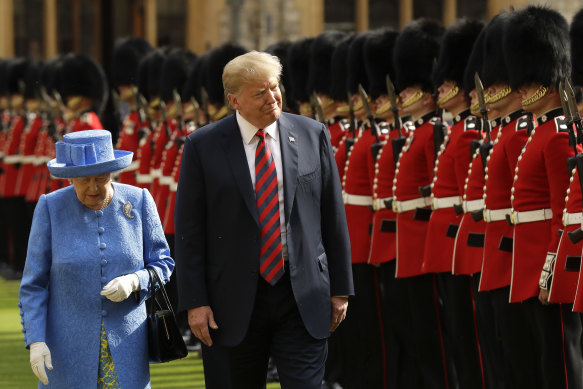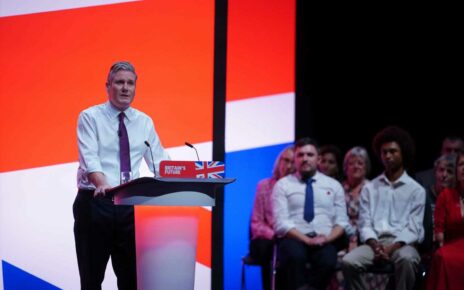She had, said the Prime Minister, “an air of authority and reflectiveness astonishing in an infant”.
Such was Winston Churchill’s assessment of the baby Elizabeth Alexandra Mary Windsor.
He didn’t yet know it – no one did – but Churchill would end up being the first of the infant’s 15 British prime ministers and probably her favourite.
Baby Princess Elizabeth, daughter of the Duke and Duchess of York, in London in 1928.Credit:Reuters
From her infancy and beyond, Lilibet (as she was known) was observed and assessed, not just by prime ministers, popes and presidents, but most especially by the public she served.
She was 27 when the St Edward’s Crown was laid on her head in Westminster Abbey in 1953. It weighed more than two kilos.
The crown was hers – and as she noted more recently, yes, crowns are heavy – so heavy you have to memorise your speeches because if you tip your head down to check notes while wearing one, you might break your neck.
Elizabeth grew from girlish new queen to old stager on the world stage.
She hosted morning teas and state visits for elected politicians, but she was anointed by God, and she saw them all off, one after the other – from Harry Truman (whom she met while still a princess, in 1951) to Donald Trump, who broke royal etiquette by walking in front of his hostess while inspecting an honour guard.
Donald Trump walks ahead of the Queen during a 2018 Presidential visit. Credit:AP
She had mixed luck with Australian prime ministers – some of them, such as Bob Hawke and Paul Keating, were Republicans (Keating famously laid a hand on her when she visited in 1992. Michelle Obama did the same in 2009, but the Queen didn’t seem to mind at all).
Other Australian PMs were big fans – notably Robert Menzies, John Howard and Tony Abbott.
The latter even asked for an audience when he was in London after he was ousted from the prime ministership. Her Majesty did not have room in her diary.
Malcolm Turnbull had a bob each way.
“Even Republicans like myself can be…very strong Elizabethans,” he said.
She was the most famous woman in the world (and one of its richest), a matriarch whose copious family laundry was not just aired in public, but secretly recorded, photographed via long-lens, and turned into a Netflix series.
She was the ultimate celebrity, but she met her celebrity with reserve and a hard wall of protective protocol.
She received people, which is to say she let people come to her – the ultimate power flex.
But so voiceless was she that she had to use handbag placement and brooch selection to signal her true thoughts.
Because here was the thing: Elizabeth II’s familiarity and constancy never amounted to intimacy.
And therein lies her mystery and the mystique of the monarchy she headed.
She was hyper-visible, but we never knew her opinions, her thoughts or her emotions.
We knew an awful lot about what happened to her, but not a lot about how she felt about any of it.
The closest we came was when she described 1992 as her “annus horribilis”, but even then, she could have been talking about her children’s divorces or her sister’s health, or the fire at Windsor Castle or maybe something else entirely, like the death of a favourite Corgi. We never knew.
As she aged, the Royal family grew more incontinent with its troubles.
There was Charles recorded on the phone to his mistress Camilla, relaying his fantasies. There was Fergie on the front page of a tabloid. There was Princess Margaret’s descent into alcoholism.
And there was the tragedy and threat of Diana, who was of the monarchy and yet against it.
Diana was the worst kind of menace – she was beloved, but most importantly, she talked.
She turned the tables on the discreet queen, who suddenly found her silence worked against her.
The public wanted a response, and as penance for Diana’s death in 1997, they wanted the Queen to talk. Eventually, she addressed her grief-struck nation, even if she had to be pressured into it.
The calamities eased for a while before ramping back up – the Queen’s son Prince Andrew, rumoured to be her favourite, was disgraced over his connection to a notorious paedophile who offered him wealth and influence.
Then there was her grandson Prince Harry, who, like his father, married a woman who decided not to play by royal rules; who wanted to strike out on her own terms.
Harry and Meghan couldn’t have chosen a more American route for their self-expression.
The stiff upper lip of the Queen’s monarchy made way for the let’s-talk-it-all-out-ism of an Oprah Winfrey special, aired in 2021. Where Diana had accused The Firm of callousness, Meghan accused it of callousness and racism.
The Queen was once again forced to show her feelings, just a little.
She put out a statement saying her family was “saddened to learn the full extent of how challenging the last few years have been for Harry and Meghan”.
The matter, she said, would be dealt with privately.
As she shrank in stature, she appeared less and less. One of her most memorable appearances was at the funeral of her husband of 73 years, Prince Philip, in April 2021.
She sat alone and bent, isolated by the COVID restrictions, grieving in a pew at St George’s Chapel.
She looked very lonely. She looked very much like Our Queen, who always put dignity before candour and form before emotion.
After Philip’s death, her frail health and mobility problems forced her to acknowledge that she could not always keep calm and carry on, cancelling her appearances even at the opening of British parliament.
Her moments in public were now brief and infrequent, and still they cost her.
The Queen was forced to rest following a full day of duties overseeing the handover of power in Downing Street this week, when she greeted the new British Prime Minister Liz Truss.
Even in the final photo released before her death, as she extended a bruise-mottled hand to her 15th prime minister, Liz Truss, that regal smile was there, even as she gripped hard on the walking stick that kept her upright. As ever, she gave the moment her best, but she held something back.
Most Viewed in World
From our partners
Source: Read Full Article



